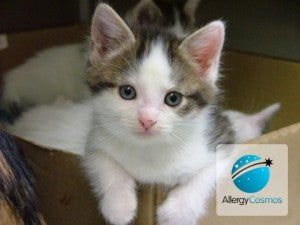Cat and house dust mite allergens are both extremely important in sensitising people to cat allergy and in producing symptoms. Both are invisible to the naked eye (in fact it is specific proteins in cat dander and house dust mite droppings that are the actual allergens). So it is important to understand how cat allergen spreads, in order to devise a clear strategy for avoiding exposure to cat allergen and thus limit allergy and asthma symptoms.
Researchers in Sydney, Australia, writing in the Journal of Allergy and Clinical Immunology, provide some significant insights into how cat allergen spreads and how clothing provides a vehicle for both mite and cat allergens to transfer from place to place. The researchers note that cat allergen, the protein Fed d 1, is found in reservoir dust at levels of 10 micrograms per gram or more in homes where a cat is in residence. But cat allergen is also widespread in public places such as schools and nurseries and is found in homes where there is no cat.
So how do cat allergens spread so far?
For house dust mite allergen, beds, carpets and soft furnishings are the most common reservoirs with concentrations between 20 and 40 micrograms per gram of dust being not uncommon. And we already know that clothing carries mite allergen, with one study showing average levels of 15.9 micrograms of Der p 1 in the upper body clothing of 35 adults. Clothing is a potent source of how cat allergen spreads because of its ability to attract dust, its proximity to the wearer and to the disturbance of dust that occurs when an item of clothing is worn.
In previous research that examined how cat allergen spreads, a group of scientists used intranasal sampling to identify cat allergen inhaled by subjects in relation to clothing worn and its allergen load. In this study, they used these techniques to distinguish the contribution of clothing over the background to allergen exposure.
The study was carried out in 11 homes, four of which had a cat in residence. The participants were asked to select an item from each one of the following five categories of clothing:
- A freshly washed T-shirt
- A T-shirt that had been worn in the previous week and not washed
- A woollen sweater
- A jacket
- A sweat shirt
Each item was put on, in the above order, and after 10 minutes of letting the dust settle, intranasal sampling was done for 15 minutes and samples were also taken from the clothing in order to better understand how cat allergen spreads. A sixth test was done with the subject not wearing any clothing on the upper body.
Another set of tests was done with participants in an office environment, focusing just on cat allergen. Fifteen workers were tested, of whom five had a cat at home. Non-cat owners were asked to wear freshly washed clothing. All had an intranasal sampling for 15 minutes and testing of upper body clothing. Testing was repeated at the end of the day. The air in the office was also sampled.
The intranasal samplers collect most particles greater than 10 microns in size entering the airways and 50 per cent of those more than 5 microns in size. The samples can be analysed in the lab for the presence of Der p 1 (house dust mite allergen) and Fel d 1 (cat allergen). The researchers used tape to pick up surface dust on clothing and a vacuum to collect reservoir dust. These were analysed for allergens in a similar way to the intranasal samples.
Both allergens were found in dust from all types of clothing items used in the home study. Levels were higher than the level found on the kitchen floor. For mite allergen, woollen sweaters and jackets carried more allergen than T-shirts, as did sweat shirts. For cat allergen, clean T-shirts contained significantly less allergen than the other items.
For both types of allergen, significantly less allergen was inhaled when wearing a clean T-shirt than when wearing other items. Also, less allergen was picked up from clean T-shirts.
In the office study, more allergen was inhaled as the day went on for non-cat owners but there was no difference between the beginning and the end of the day for the cat owners. Similarly, the non-cat owners picked up more and more particles containing allergen as the day went by but there was no difference between particle count at the beginning and end of the day for the cat owners. All workers had allergens in the dust from their clothing and levels were higher (6.58 micrograms per gram) in cat owners than in non-cat owners (1.92 micrograms per gram). Air sampling revealed significant levels of cat allergen of 12.5, 19.8 and 31.3 micrograms per cubic metre in the three sampling locations. In both home and office settings, there was a strong link between the amount of allergen present on, and in, clothing and the amount inhaled.
How can I prevent cat allergens from spreading?
The researchers conclude that their findings strongly support the theory that clothing is an important source of exposure for both mite and cat allergen and an essential part in understanding how cat allergen spreads. Exposure increases with clothing that is not freshly washed. Wearing a woollen sweater (which tends to be washed less often than a T-shirt) increases exposure around 10-fold compared to background levels. The most effective way to limit the spread of cat allergen on clothing is to wash it with Allergen Wash Laundry Detergent, which naturally breaks down the cat allergy symptom causing protein.
Cat allergen was found on all kitchen floors in the home study, even if a cat was not in residence. This explains why symptoms may be experienced even in the absence of a cat. In the office, non-cat owners were clearly picking up cat allergen from colleagues who did have a cat as the day wore on. The researcher points out that we know little of the mechanisms by which allergen-containing particles are released from the surface of clothes and other items such as carpet. But their findings do suggest that particles in and on clothes do certainly enter the respiratory system if they are not captured first through the use of a proper air purifier. The best advice seems to be to wash clothes with allergen wash laundry detergent, particularly if you have a cat, and maybe wear layers of cotton rather than wool.
Source: De Lucca SD et al (2000). Exposure to mite and cat allergens on a range of clothing items at home and the transfer of cat allergen in the workplace. Journal of Allergy and Clinical Immunology 106; 874-879




